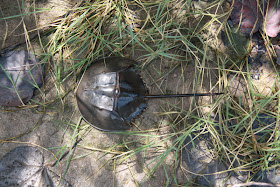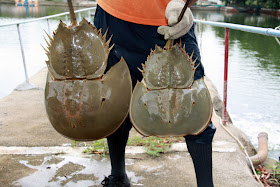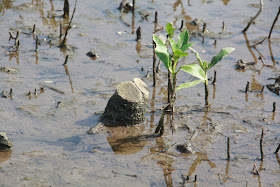The following photographs are of juvenile Tachypleus tridentatus and their foraging trails at the intertidal mudflat at San Tau, Lantau, Hong Kong on 19 September 2010:
Saturday, 23 June 2012
Tuesday, 19 June 2012
Carcinoscorpius rotundicauda. San Tau, Hong Kong on 19 September 2010.
The following photographs are of a female Carcinoscorpius rotundicauda (Mangrove horseshoe crab) which was entangled and abandoned in a monofilament fishing net at San Tau, Lantau, Hong Kong on 19 September 2010.
This horseshoe crab, which was still alive was cut free and released back to the sea.
This horseshoe crab, which was still alive was cut free and released back to the sea.
Tachypleus tridentatus. Tung Chung, Hong Kong on 23 September 2010.
The following photographs are of juvenile Tachypleus tridentatus and their foraging trails at the intertidal mudflat at Tung Chung, Lantau, Hong Kong on 23 September 2010:
Juvenile T. tridentatus.
Foraging trails of juvenile T. tridentatus.
Saturday, 16 June 2012
Carcinoscorpius rotundicauda. Tung Chung, Hong Kong on 23 September 2010.
The following photographs are of dead Carcinoscorpius rotundicauda (Mangrove horseshoe crab) found alongside a stream which runs across the mudflat at Tung Chung, Lantau, Hong Kong on 23 September 2010.
The horseshoe crabs hanging in the mangrove bush are a male and female, possibly a mating pair which were swimming up the stream to spawn in the mangroves that line the stream. The animal lying on its back is a dead female C. rotundicauda.
Streams are critical to the ecology of C. rotundicauda, because they use stream courses to navigate across beaches to reach the mangrove stands where they spawn. C. rotundicauda has also been observed to spawn in the lower reaches of streams in Hong Kong.
Carcinoscorpius rotundicauda. Tung Chung, Hong Kong on 6 May 2011.
The following photographs are of a male Carcinoscorpius rotundicauda (Mangrove horseshoe crab) which was caught by a fisherman in the Tung Chung stream, Lantau, Hong Kong on 6 May 2011.
A monofilament fishing net, which is similar to the one that was used to catch this horseshoe crab can be seen stretched across the stream in the first photograph.
Carcinoscorpius rotundicauda. Ha Pak Nai, Hong Kong on 19 August 2009.
The following photographs show a spawning pair of Carcinoscorpius rotundicauda (Mangrove horseshoe crab), in the muddy bank of a stream at Ha Pak Nai, Deep Bay, Hong Kong on 19 August 2009.
Carcinoscorpius rotundicauda. Ha Pak Nai, Hong Kong on 1 August 2009.
The following photographs show a mating pair of Carcinoscorpius rotundicauda (Mangrove horseshoe crab), crossing a beach along the course of a stream at Ha Pak Nai, Deep Bay, Hong Kong on 1 August 2009:
Friday, 15 June 2012
Tachypleus tridentatus. Ha Pak Nai, Hong Kong on 15 September 2009.
The photograph below shows a mating pair of Tachypleus tridentatus (Chinese horseshoe crab), caught in a fisherman’s net in the mouth of a stream at Ha Pak Nai, Deep Bay, Hong Kong on 15 September 2009.
The female on the left of the picture is 35 centimetres across the head shield. The smaller male is 25 cms across.
In the late 1960’s this fisherman once caught 200 Chinese horseshoe crabs in a single night and in the 1960's and 1970's such large catches of horseshoe crabs were not uncommon at Ha Pak Nai. In 2009 he caught just this one mating pair.
Undisturbed streams, particularly in their lower reaches are critical to horseshoe crab ecology in Hong Kong, because horseshoe crabs use stream courses to navigate across beaches and both T. tridentatus and C. rotundicauda have been observed to spawn in the lower reaches of streams in Hong Kong.
Monday, 11 June 2012
Mangrove stand at Tai Ho Wan SSSI cut down.
The Tai Ho Stream, Lantau, Hong Kong was designated a Site of Special Scientific Interest (SSSI 63) in 1999. Unfortunately the protections offered by the SSSI designation in Hong Kong are limited, as the following photographs (taken on 7 June 2012) of one of the mangrove stands in the area shows:





















































